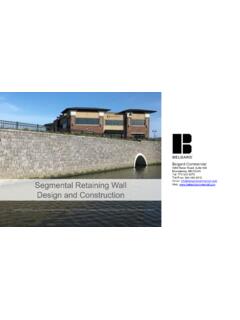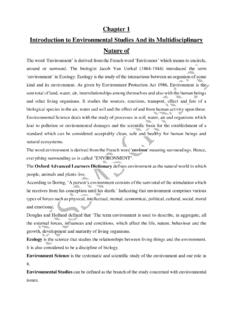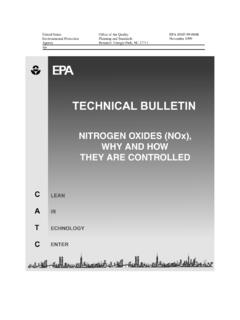Transcription of Life Cycle Assessment of Buildings: A Practice Guide
1 Funded by: life Cycle Assessment of Buildings: A Practice GuidePublished by:The Carbon Leadership ForumLife Cycle Assessment of Buildings: A Practice GuideVersion 2019 Published by:The Carbon Leadership Forum Department of Architecture University of TeamKathrina SimonenMonica HuangBarbara X. RodriguezLindsay TodaroGraphics TeamMazohra ThamiThipok CholsaipantMeghan LewisFunded by:Project Sponsors Carbon Leadership Forum SponsorsDiamond SponsorsCarbon InnovationsMithunStopWasteThe Russell Family FoundationPlatinum SponsorsArupCentral ConcreteEagle Rock AggregatesInterfaceMithunSkanskaThornton TomasettiGold SponsorsClimate EarthMagnusson Klemencic AssociatesNRMCAO wens CorningSimpson Gumpertz & HegerThinkstepUrban FabrickWalter P MooreCopyright:Licensed under a Creative Commons Attribution International LicenseDOI: Cycle Assessment of Buildings.
2 A Practice Guide Page 2 ABOUTINTRODUCTIONREFERENCESIMPLEMENTATIO N12345 Page 3 life Cycle Assessment of Buildings: A Practice Guide | ACKNOWLEDGMENTSA cknowledgmentsThe creation of this Practice Guide was funded by the Charles Pankow Foundation, the Oregon Department of environmental Quality, and Skanska USA. The Practice Guide was developed with the assistance of a diverse advisory committee who provided feedback through review of drafts and periodic discussions. The advisory committee was divided into a professional working group, who focused on the language and graphics, and a technical working group, who focused on refining LCA standard members of the advisory committee are listed below.
3 Their contributions were critical to the development of this document and are greatly appreciated. Individuals who went above and beyond are recognized in bold Working GroupTechnical Working GroupNameOrganizationNameOrganizationBra d BenkeLMN ArchitectsAlexandra LebertCSTBB ruce KingEcological building NetworkAthina PapakostaSturgis Carbon ProfilingChristopher DrewAdrian Smith + Gordon GillCarrie DossickUniversity of WashingtonDavid ShookSOMC atherine De WolfEPFLD uncan CoxThornton TomasettiDon DaviesMKAJeff FrostBrightworksFrances YangArupJonathan RoweFacebookHenrique Mendon aeToolKelly RobertsWalter P MooreJeremy GregoryMITK elsey Rose PriceMKAK elly
4 RobertsWalter P MooreLarry StrainSiegel and StrainMatt BowickAthena Sustainable Materials InstituteMeghan LewisMithunNuno da SilvaThinkstepMelissa WackerleAmerican Institute of ArchitectsPatrick SmithUniversity of MinnesotaMyrrh CaplanSkanksa USAP eter CanepaOregon DEQN icole WangSOMR odrigo CastroBionovaWil SrubarUniversity of ColoradoSimon SturgisSturgis Carbon ProfilingWes SullensUSGBCS tephanie CarlisleKieranTimberlakeWolfgang WernerUrban Fabrick, 4 ABOUTLife Cycle Assessment of Buildings: A Practice Guide | AboutThis Practice Guide introduces the use of life Cycle Assessment (LCA) to analyze the environmental impacts of buildings.
5 The intent of this Practice Guide is to help building professionals understand why and how to use LCA in their work. It addresses basic questions such as: How do buildings impact the environment? What is LCA and how is it used to evaluate buildings? What is the process of performing an LCA of a building ?The first part of this Practice Guide is the Introduction, which describes how buildings affect the environment and how LCA can be used to quantify environmental impacts. The second part of the Practice Guide is the Implementation, which presents the five key steps to conducting an LCA of a building .
6 This Practice Guide is accompanied by a supplemental web page containing Online Resources, which includes technical guidance documents for LCA tool developers and experts, and a growing list of building -related LCA resources, including building -specific LCA tools or navigation bar of the document, shown on the right edge of each page, reflects the general structure of this Practice this Practice Guide caters to a North American audience, the principles of LCA are generally applicable to any geographic region, with differences residing in the relevant standards, rating systems, datasets, and 5 life Cycle Assessment of Buildings: A Practice Guide | ABBREVIATIONSA bbreviationsAPAcidification potentialCO2(e)Carbon dioxide (equivalent)ENEPAE uropean Standard (French: norme , German.)
7 Norm ) environmental Protection Agency (United States)EPEutrophication potentialEPDE nvironmental product declarationEUIE nergy use indicatorFSC Forest Stewardship CouncilGHGG reenhouse gasGWPG lobal warming potentialIPCCI ntergovernmental Panel on Climate ChangeISOI nternational Standards OrganizationkgkilogramsLCALife Cycle assessmentLCILife Cycle inventoryMEPM echanical, electrical, plumbingNGONon-governmental organizationNISTN ational Institute of Standards and TechnologyODPO zone depletion potentialReqSLRequired service lifeRSPR eference study periodSFIS ustainable Forestry InitiativeSFPSmog formation potential (also known as formation of tropospheric ozone )UKUnited KingdomUNUnited NationsUSUnited StatesUVUltravioletVOCV olatile organic compoundsIntroductionPart ALife Cycle Assessment of Buildings: A Practice Guide ABOUTINTRODUCTIONREFERENCESIMPLEMENTATIO N12345 Page 7 life Cycle Assessment of Buildings.
8 A Practice Guide | How do buildings impact the environment?Constructing a building and using it for many years produces long-lasting impacts on human health and the environment. life Cycle Assessment (LCA) is the rapidly evolving science of illuminating these impacts in terms of their quality, severity, and building generates environmental impacts throughout its life Cycle . The various stages of a typical life Cycle as defined in LCA are: A: the production and construction stages, B: the use stage, C: the end-of- life stage, and D: externalized impacts beyond the system production stage involves the energy and resources used to extract raw materials, to transport the materials to product manufacturing facilities, and to produce the final building products.
9 The construction stage involves the transportation of materials to the construction site as well as the energy used to power the construction equipment, to supply supporting construction materials, and to dispose of any waste generated during the construction process. The use stage involves the impacts of occupying a building over its lifetime due to lighting, heating, water use, and any materials used for maintenance, repairs, and replacement. The end-of- life stage involves the demolition and disposal of the building as well as waste processing (if the building is not repurposed or improved for further occupancy or use).
10 Finally, the last stage gathers all of the miscellaneous effects of reusing, recycling, and/or recovering materials, energy, or water from the project. These effects are called externalized impacts because they are manifested outside of the system boundary, which is defined as the physical limits of the LCA the life Cycle stages of a building , emissions and other pollutants are produced and released into the surrounding environment. A visual depiction of where these emissions may occur during a building s life Cycle is shown in Figure Gate? Grave?The beginning of the life Cycle is also referred to as the cradle, while the exit point of the manufacturing facilities is known as the gate, and the end of the life Cycle is known as the grave.






